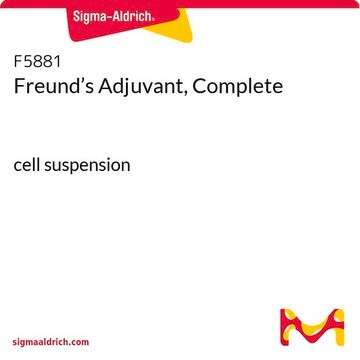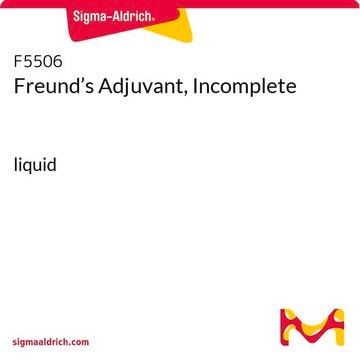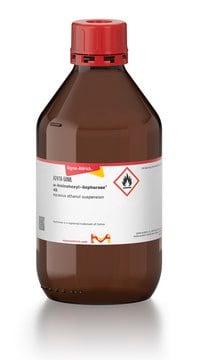This depends on the particular situation, and the answer depends more on the coupled ligand than the resin itself. The most important criterion is to choose a buffer that is not harmful to the ligand. It is common to include 20% ethanol or preservatives like sodium azide or thimerosal (~0.02%) to inhibit potential bacterial growth.
C9142
Cyanogen bromide-activated-Sepharose™ 4B
lyophilized powder
Synonym(s):
Cyanogen bromide-activated Agarose
About This Item
Recommended Products
form
lyophilized powder
Quality Level
technique(s)
affinity chromatography: suitable
matrix
Sepharose 4B
matrix active group
cyanate or related structures
matrix spacer
1 atom (when ligands are coupled via isourea derivative or related linkage)
swelling
1 g swells to 4-5 mL
particle size
45—165 μm
storage temp.
2-8°C
Looking for similar products? Visit Product Comparison Guide
General description
C9142-15G′s updated product number is GE17-0430-01
Application
- in the purification of clusterin from serum by an immunoaffinity-based separation procedure
- in affinity chromatography to isolate Leishmania donovani protein antigens from the urine of visceral leishmaniasis patients
- in affinity chromatography for the isolation of haptoglobin from human serum
Physical form
Legal Information
related product
replaced by
Storage Class Code
11 - Combustible Solids
WGK
WGK 3
Flash Point(F)
Not applicable
Flash Point(C)
Not applicable
Personal Protective Equipment
Choose from one of the most recent versions:
Certificates of Analysis (COA)
Don't see the Right Version?
If you require a particular version, you can look up a specific certificate by the Lot or Batch number.
Already Own This Product?
Find documentation for the products that you have recently purchased in the Document Library.
Customers Also Viewed
-
When using Product C9142, Cyanogen bromide-activated-Sepharose®, is there a particular storage buffer that I should use after I've coupled my ligand to the resin?
1 answer-
Helpful?
-
-
What is the Department of Transportation shipping information for this product?
1 answer-
Transportation information can be found in Section 14 of the product's (M)SDS.To access the shipping information for this material, use the link on the product detail page for the product.
Helpful?
-
-
How are proteins attached to the Cyanogen bromide-activated Sepharose® in Product C9142?
1 answer-
Coupling of molecules to CNBr-activated Sepharose® is usually via amine groups. In the case of proteins, this usually means the epsilon amines (exocyclic amines) of lysine groups.
Helpful?
-
-
What kind of volume should I use for my ligand to couple to the Cyanogen bromide-activated Sepharose®, Product C9142?
1 answer-
It is best that the coupling ligand should not be in too dilute a solution. In general, a volume ratio of 0.5 to 1 of coupling solution to CNBr-activated Sepharose® is recommended.
Helpful?
-
-
My ligand is in Tris buffer. Can I use Product C9142, Cyanogen bromide-activated-Sepharose®, with this sample?
1 answer-
Because Tris is an amine-containing buffer, we do not recommend coupling of samples in Tris buffer to the CNBr-activated Sepharose®. Tris will react with the CNBr groups and remove sites for ligand coupling. We would not recommend use of any amine-containing buffer in the coupling reaction. However, after the ligand has been added in the coupling reaction, then it is OK to use amine-containing buffers to block the remaining sites (e.g. ethanolamine, glycine).
Helpful?
-
-
After I've washed and prepared the resin in Product C9142, Cyanogen bromide-activated-Sepharose®, for the coupling reaction, how long can I wait before coupling the ligand to the resin?
1 answer-
We would recommend coupling the ligand immediately after washing and preparing the resin. This is because the reactive groups hydrolyze in the basic solution conditions of the preparation steps. The solutions used in the coupling reaction should also be kept cold (2-8°C) during the procedure.
Helpful?
-
-
Should I use a desiccator environment for storage of Cyanogen bromide-activated-Sepharose®?
1 answer-
It is a good idea to store the CNBr-activated agarose products in as dry an environment as possible, because the reactive groups are very moisture-sensitive.
Helpful?
-
Active Filters
Our team of scientists has experience in all areas of research including Life Science, Material Science, Chemical Synthesis, Chromatography, Analytical and many others.
Contact Technical Service














